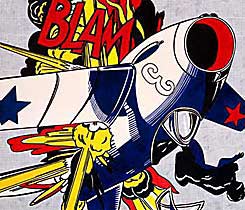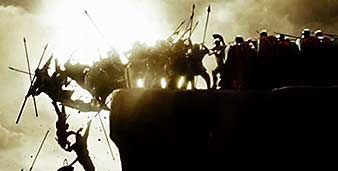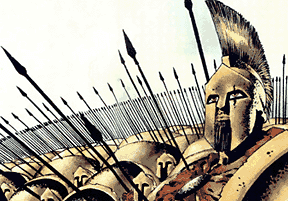300: America becomes Sparta
A certain strain of contemporary art has examined, or taken inspiration from, the aesthetics and pulp visions of the American comic book – of course the Pop art movement and influential artists like Lichtenstein and Rauschenberg come to mind. Comics have also influenced American cinema, a trend I’m not terribly fond of, and the latest comic book to hit the silver screen is 300. Despite the hullabaloo over its eye-popping visual effects, 300 is indicative of nothing more than American movie making having hit rock bottom.

Based on Frank Miller’s graphic novel about the 300 Spartans who held back a million Persian soldiers at a narrow pass during the Battle of Thermopylae in 480 B.C., Director Zack Snyder’s 300 has little to do with history and everything to do with a modern disposition towards militarism now embraced by far too many Americans. As you might imagine, 300 depicts the Spartans as gallant heroes, warriors who gave their all in the defense of the world’s first democracy – obviously the audience is meant to identify with the soldiers of Sparta. But the danger in such a simplistic reading of history is that Sparta, far from being a society worthy of emulation, was above all else a militaristic state, even the term “spartan” refers to something severely utilitarian – like a military barracks.

That the Greek press has ravaged 300 as a falsification of their nation’s history should come as no surprise (the film opened in Athens on March 9th). But why should Americans bother with what Greeks have to say about their own history, when we can learn all we need to know from a right-wing xenophobic American comic book artist born in Olney, Maryland.
Some of what Frank Miller said at San Francisco’s WonderCon comic book convention in 2006 bears repeating, as it puts the movie 300 in context. Miller revealed that his upcoming graphic novel, Holy Terror, Batman!, will feature the “Caped Crusader” fighting the al-Qaida terror network. Aside from promising that “Batman kicks al-Qaida’s ass,” Miller went on to say the following about his forthcoming graphic novel: “Not to put too fine a point on it – it’s a piece of propaganda. I just think it’s silly to have Batman out chasing the Riddler when you’ve got al-Qaida out there.” Miller went on to say that “I wish the entertainers of our time had the spine and the focus of the ones who faced down Hitler.” Apparently Miller thinks he is just such an entertainer.
300 is a testosterone fueled war fever-dream that offers a non-stop and ferocious display of disembowelments, spraying blood, and beheadings – and some film critics have unfortunately referred to this horrific violence as choreography or stylization. The unrelenting carnage in 300 is never connected to a sense of moral burden or remorse – it is simply what “real men” do. Compared to Flags of Our Fathers, Clint Eastwood’s insightful rumination on the genuine sacrifices and brutalities of war, 300 is an undisguised war enthusiast’s wet dream. When the film’s Spartan King Leonidas leads his army into battle yelling, “For Freedom!”, those words are meant to have a propagandistic effect upon its audience. Clearly, 300 is a brazen allegory for the war the U.S. is fighting in Iraq and preparing to fight in Iran.
That more than a few critics have referred to 300 as an “erotic” film is also telling. In Susan Sontag’s 1975 essay on fascist aesthetics, Fascinating Fascism, she stated that fascist art is: “both prurient and idealizing. A utopian aesthetics (physical perfection; identity as a biological given) implies an ideal eroticism: sexuality converted into the magnetism of leaders and the joy of followers. The fascist ideal is to transform sexual energy into a “spiritual” force, for the benefit of the community.” Sontag went on to note that fascism: “stands for an ideal or rather ideals that are persistent today under the other banners: the ideal of life as art, the cult of beauty, the fetishism of courage, the dissolution of alienation in ecstatic feelings of community; the repudiation of the intellect; the family of man (under the parenthood of leaders.)” – all of which appear larger than life in 300.

Following George W. Bush’s 2007 State of the Union address, National Public Radio broadcast, Writers and Artists Describe the State of the Union, a show where several guests had the opportunity to offer their assessments of national affairs – Frank Miller was one of those voices. Before insisting that Iraq had actually declared war on the U.S. – an assertion not even made by President Bush – Miller launched a fanatical tirade against a nameless, faceless, “other” he would like to see vanquished by American military force:
“For some reason, nobody seems to be talking about who we’re up against, and the sixth century barbarism that they actually represent. These people saw people’s heads off. They enslave women, they genitally mutilate their daughters, they do not behave by any cultural norms that are sensible to us. I’m speaking into a microphone that never could have been a product of their culture, and I’m living in a city where three thousand of my neighbors were killed by thieves of airplanes they never could have built.”
“They” are our implacable enemies, but truth, justice and the American way will free the world of “these people.” Now the real meaning behind the jingoistic tagline for 300 comes into sharp focus – Prepare for glory!

